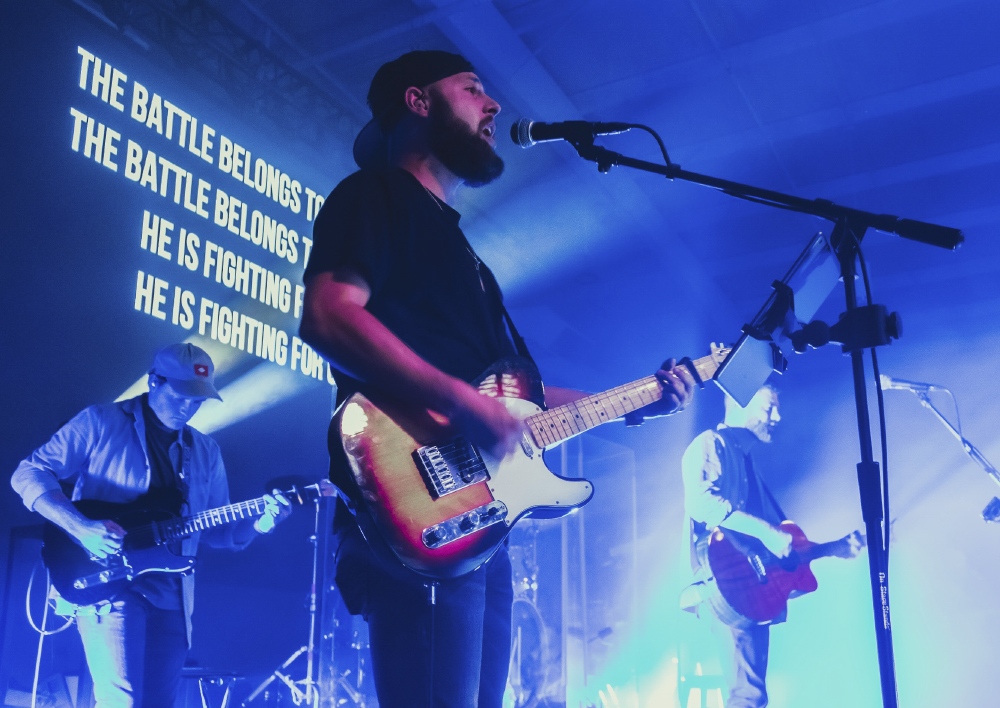
As mentioned earlier, in an effort to create a stereo image with a split input, an additional trick that can be done with a digital desk is to add some input delay to one of the two “split” channels. I’ve found that around 20 to 40 milliseconds (ms) of delay on one of the inputs creates a cool doubling effect that makes the two channels sound bigger and wider in the stereo mix than a single input.
Another technique is to send the mono guitar source to a stereo FX unit, either internally on a digital console or externally with an analog console. If you use a delay or chorus/harmonizer effect, then return the stereo FX unit outputs into two console channels and pan these channels hard left and right, they can be added to the mono guitar mic to add width to a single guitar player’s sound.
Two (Or More) Inputs
Now let’s look at guitar rigs that have two or more inputs, such as stereo guitar setups. This situation presents us with some decisions that must be made as far as placing them in the stereo mix.
One option is to let each rig “be what it is meant to be” and simply pan each pair of inputs hard left and right, which provides two big stereo sounds. That’s all good unless you want to have a little bit of “localization” of the house left and house right guitar player’s sounds. This gets tricky as you will now be taking a stereo source and panning it partially to left or right in the mix, which compromises the stereo fullness of the sound.
Here’s a technique I recently used to attain the option of having each player’s sound localized in house left or right to match where they are on stage. It also gave me the option of bringing each player up in full stereo for a guitar solo or highlighted piece.
I start by sending each guitar input post-fader to a stereo aux bus and then return that same bus into two stereo channel pairs in the console. Note: Un-assign the main guitar inputs from the stereo mix bus. Assign only the two stereo aux bus return channels to the stereo mix bus. Failure to do this with a digital console can introduce comb filter problems.
Next I pan one player’s stereo aux return to “3 o’clock” and the other player’s stereo aux buss return to “9 o’clock.” These stereo channels are labeled “MONO GTR” even though they’re both stereo channels panned to one side or the other. With the second pair of stereo aux returns, I pan the two return channels hard left and right for each player, and label these stereo inputs “ST GTR.”
Now it’s time to assign each player’s mono and stereo guitar aux returns to separate VCAs. This eats up four VCAs but it’s worth it if you can afford the real estate.
With the “mono” and “stereo” guitar channels assigned to VCAs, you can now choose to bring up each guitar player’s sound as a panned “mono” sound or a wider “stereo” sound. If a song starts with two separate guitar parts happening and you want to hear each player’s part localized to the left or right in the mix, bring up the MONO GTR VCA. If one player takes a solo, bring up the ST GTR VCA and it will move back to the middle of the stereo field, yet with a wider stereo sound.
A couple of final tricks: 1) Send the stereo aux return channel to a stereo effect like a harmonizer or chorus, and blend some of it into the ST GTR VCA for an even wider, bigger stereo sound. Also blend the amount of FX to taste. 2) EQ the stereo aux return channel a little “darker” (add some 250 Hz and cut some 2.5 kHz) to beef it up.
